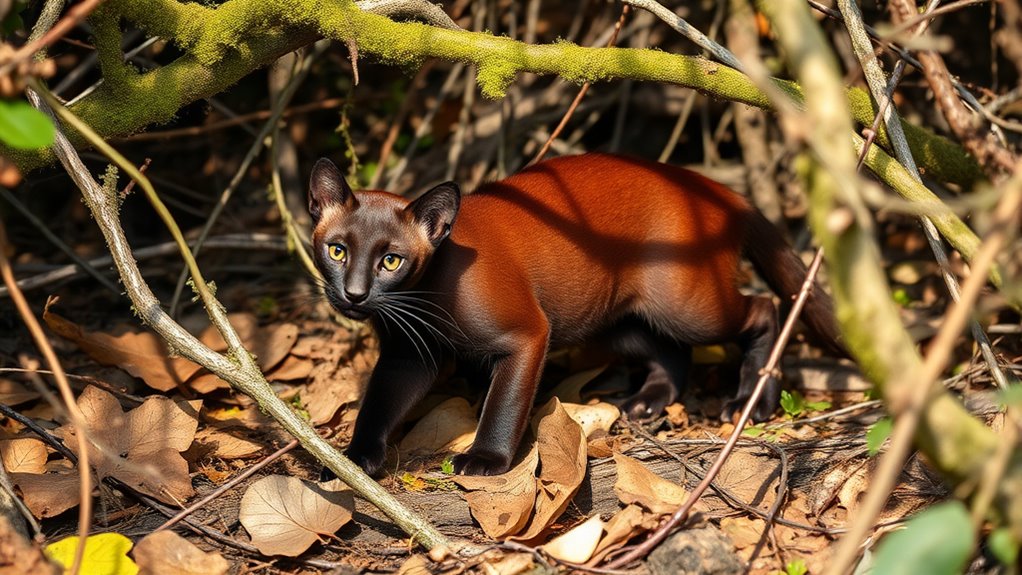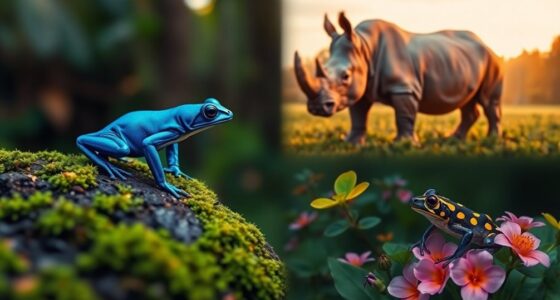The legend of the Jaguarundi in Texas persists thanks to reports of small, sleek felines darting through brush and forested areas. Though rarely seen, some believe this elusive wild cat still hides in dense habitats, blending seamlessly with its surroundings. Scientific evidence remains limited, but ongoing research and camera traps keep the mystery alive. Curiosity grows as stories and sightings continue—if you keep exploring, you’ll uncover more about this secretive native feline.
Key Takeaways
- The jaguarundi is native to Central and South America, with occasional reports in southern Texas, but its confirmed presence remains uncertain.
- Its slender body, long tail, and sleek appearance distinguish it from other wild cats in Texas.
- Sightings are rare and often anecdotal, fueling local legends and folklore about a secret feline in the region.
- Habitat loss and fragmentation threaten potential populations, making verified sightings and conservation efforts crucial.
- Modern technology like camera traps and genetic analysis are being used to investigate and confirm the jaguarundi’s presence in Texas.
Origins and Physical Characteristics of the Jaguarundi

The Jaguarundi, a small wild cat native to Central and South America, has a distinctive appearance that sets it apart from other felines. Its musculoskeletal traits include a slender body, long tail, and short legs, giving it a sleek profile ideal for agility. You’ll notice its coat varies from solid gray and reddish to brown, aiding in camouflage. Lightweight designs for easy transport are often used in survival gear, making them a useful analogy for understanding the Jaguarundi’s adaptation to its environment. The genetic origins of the Jaguarundi trace back to ancient felid lineages, with DNA studies linking it closely to other small wild cats in the New World. Its evolutionary path suggests adaptation to diverse habitats, from dense forests to open areas. These unique morphological and genetic traits help the Jaguarundi thrive in its native environments and distinguish it from similar species. Additionally, its ability to adapt to various environments underscores its resilience, much like survivalists who prepare for different scenarios.
Historical Sightings Across Texas

You might have heard about early reports of strange cats in Texas, sparking curiosity about their origins. Today, people share modern stories of encounters, keeping the legend alive. Certain areas stand out as hotspots where sightings seem to cluster, hinting at the jaguarundi’s possible range. Interestingly, some enthusiasts suggest that the native habitat of the jaguarundi extends into various parts of Texas, supporting these ongoing sightings.
Early Sightings Reported
Early reports of the jaguarundi in Texas date back to the 19th century, when settlers and explorers occasionally claimed to see a small, elusive feline darting through the brush. These sightings fueled local stories, blending fact with myth, and adding to the state’s collection of mythical creatures and urban legends. Some witnesses described a cat that seemed too unusual to be a typical bobcat or housecat, sparking curiosity and suspicion. Over the years, these reports persisted, often dismissed as misidentifications or exaggerated tales. Yet, they kept the legend alive, leaving a trail of mysterious encounters that hint at a hidden, wild feline lurking in Texas’s wilderness. These early sightings laid the groundwork for the ongoing debate about whether the jaguarundi truly roams undetected across the state. The integration of advanced technology in wildlife monitoring could help verify these historic claims and shed light on this enigmatic creature, especially through camera traps and other non-invasive methods. Additionally, understanding spiritual energy and how it influences perception might explain some of the mysterious sightings reported over the years, adding a layer of intrigue to these encounters. Recent developments in genetic analysis might also help determine if evidence of the jaguarundi has been overlooked or misidentified in past investigations.
Modern Encounter Stories
Have modern sightings of the jaguarundi in Texas continued to puzzle residents and researchers alike? Many reports have emerged over recent years, fueling local urban legends about this elusive wild cat. Witnesses describe seeing a small, sleek animal darting through brush or crossing rural roads, often in areas where wildlife conservation efforts are active. These sightings challenge the idea that the jaguarundi is extinct or rare in Texas, keeping the mystery alive. Some skeptics dismiss these stories as misidentifications, but others believe they point to a hidden population. Additionally, adaptive learning technologies are being used in wildlife monitoring to better identify species like the jaguarundi through image recognition. These technological advances are helping to shed light on the presence of cryptic species that are difficult to observe directly. The use of remote sensing and camera traps has also increased the chances of confirming sightings and understanding their habitat preferences. Regardless, these modern encounter stories keep the legend alive, prompting further investigation and conservation interest. They remind us that Texas’s wilderness still holds secrets waiting to be uncovered, blending folklore with ongoing wildlife conservation efforts.
Geographic Hotspots Identified
Historical sightings of the jaguarundi across Texas reveal specific geographic hotspots where reports have been concentrated over the years. These areas often fuel local urban legends, hinting at a secret wild cat lurking in the shadows. Many enthusiasts and skeptics alike have shared stories from regions like the Rio Grande Valley and parts of Central Texas, where wildlife photography sometimes captures fleeting images that resemble the elusive feline. These hotspots become focal points for those seeking proof of the jaguarundi’s existence, sparking debates and further sightings. If you’re exploring Texas’s wilderness, pay attention to these legendary locations, as they hold the most promise for uncovering the truth behind this secretive species. Trustworthy sources and ongoing research, including wildlife tracking techniques, continue to keep the legend alive, encouraging more people to explore and document potential sightings. Your search might reveal more than just local stories—it could uncover a hidden piece of Texas’s wild history. Additionally, natural signs like footprints, scat, and scratching marks can provide crucial evidence, especially when combined with knowledge of beach environments and how wave and wind patterns might influence the presence of animal tracks in coastal areas. In some cases, understanding animal behavior can help distinguish genuine jaguarundi signs from other wildlife activity.
Habitat and Range Within the State
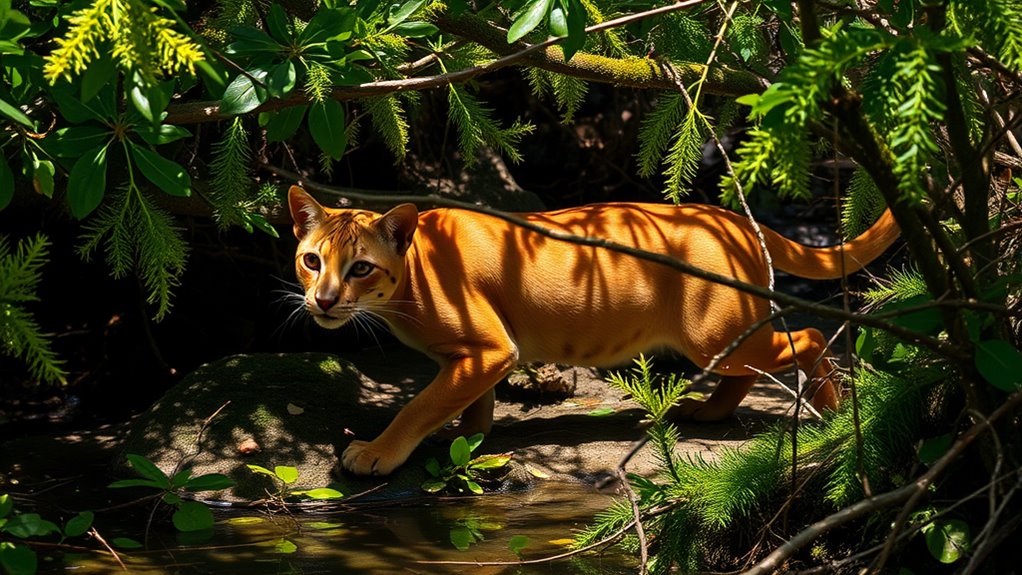
The jaguarundi’s habitat within the state is primarily characterized by dense forests, shrublands, and open areas that provide ample cover and hunting grounds. However, urban development increasingly fragments these environments, reducing suitable spaces for this elusive cat. Climate change also impacts its range, altering vegetation patterns and availability of prey. As temperatures rise and weather patterns shift, jaguarundis may be forced to seek new habitats or face population declines. You might find them in remote, less disturbed regions, but expanding urban areas threaten to push them further into isolated pockets. Protecting their natural habitat requires addressing these threats, ensuring that forests and shrublands remain viable refuges. Without intervention, the jaguarundi’s range within Texas could markedly diminish, making sightings rarer. Additionally, habitat fragmentation caused by human activities further hampers their ability to thrive and reproduce effectively, emphasizing the importance of conservation efforts. Maintaining natural habitats is crucial for supporting their populations and ensuring their continued presence in the region.
Differentiating the Jaguarundi From Similar Cats

To tell the Jaguarundi apart from similar cats, you’ll want to focus on its unique physical features like its slender body and short legs. Its behavior and preferred habitat also set it apart, as it tends to be more active during the day and favors dense forests. Recognizing these differences helps you distinguish the Jaguarundi from other small wild cats more easily. Additionally, understanding the diversification in retirement portfolio can provide insights into the importance of recognizing unique evolutionary traits among species. Being aware of regional habitats, such as those in Texas, can further aid in identifying these elusive creatures, emphasizing the significance of regional knowledge for wildlife enthusiasts. Knowing about species differentiation enhances your ability to identify the Jaguarundi accurately in the wild. Understanding evolutionary adaptations can also help in recognizing how this species has developed distinct characteristics to thrive in its environment.
Physical Appearance Differences
Jaguarundis can be distinguished from similar cats by their slender, elongated bodies and small heads. Unlike other wild cats, their fur often features subtle camouflage patterns that help them blend into dense vegetation. Their coat color varies from reddish to grayish tones, aiding in concealment. You’ll notice that their ears are small and rounded, contributing to their sleek appearance. Additionally, their feline vocalizations are distinct; they produce a range of sounds, including chirps and whistles, that differ from the growls or roars of larger cats. These vocal signals often serve as communication cues in their dense habitats. By observing these physical traits and listening to their unique sounds, you can better differentiate the Jaguarundi from other wild feline species.
Behavior and Habitat
Have you ever wondered how to distinguish a Jaguarundi’s behavior and habitat from that of similar wild cats? Their habitat preferences set them apart; Jaguarundis prefer dense forests and shrublands, often near water, unlike bobcats or ocelots that favor different environments. Their behavioral patterns also differ—Jaguarundis are active during the day, exhibiting swift, agile movements, while others are mostly nocturnal. Additionally, their unique physical features help in identifying them from other small wild cats. Recognizing their adaptations can provide further clues to their elusive nature and distinguish them from other felines. For example, their tail length is notably different, aiding in quick identification. Understanding their activity patterns is crucial, as it sets them apart from similar species with different schedules.
Scientific Studies and Evidence
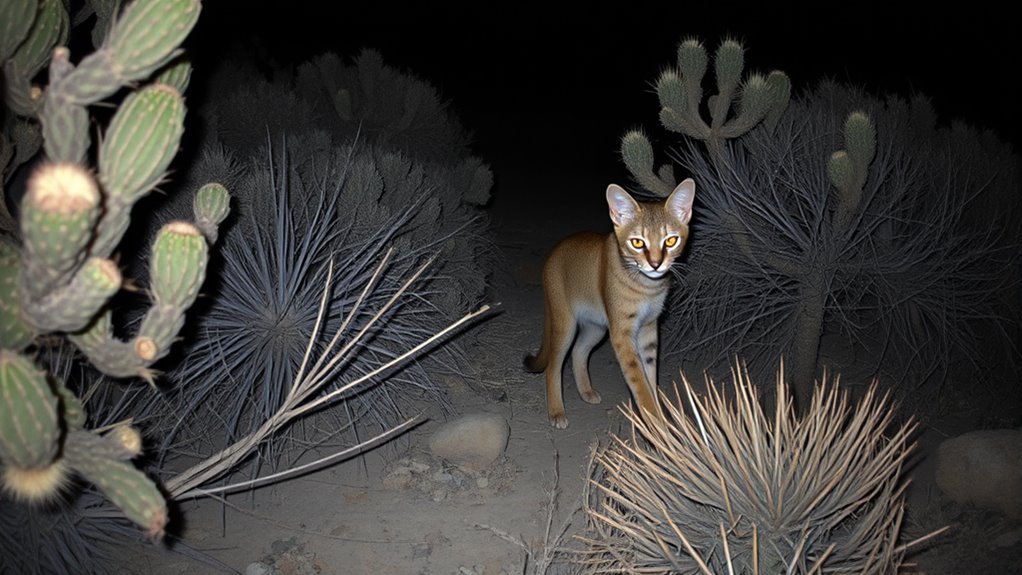
Scientific studies and evidence supporting the existence of the jaguarundi are limited but intriguing. Unlike mythical creatures or urban legends, tangible proof remains scarce, yet some sightings and tracks suggest it might still roam Texas’s wilderness. Researchers have conducted camera trap surveys and examined physical evidence like footprints and fur samples, but conclusive identification proves difficult. Many reports cite elusive behavior, fueling speculation rather than certainty. While mainstream science remains skeptical, these sporadic pieces of evidence keep the jaguarundi’s mystery alive. You might find it tempting to dismiss these as mere folklore, but the ongoing curiosity and unexplained sightings suggest there’s more to uncover. The lack of definitive scientific proof only adds to the creature’s enigmatic allure, fueling speculation and debates among enthusiasts. Unconfirmed sightings continue to spark interest and keep the legend alive among wildlife enthusiasts. Additionally, advancements in wildlife tracking technology may someday provide clearer insights into this elusive predator.
Legends and Local Folklore Surrounding the Creature
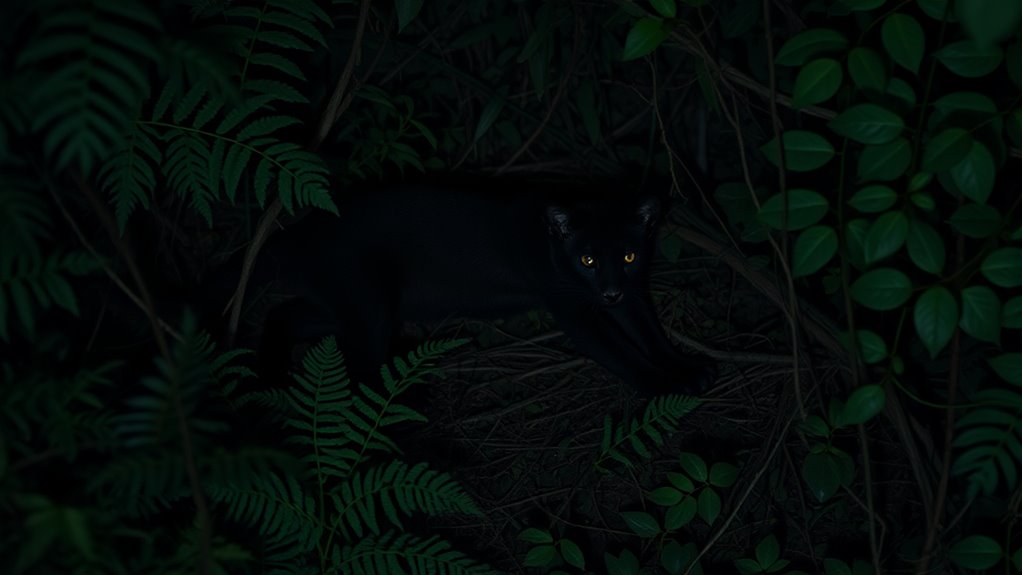
Beyond the sparse scientific evidence, stories and legends from local communities keep the mystery of the jaguarundi alive. Many folklore tales describe it as a mythical creature lurking in the shadows of Texas forests, fueling speculation about its true nature. Some residents swear they’ve seen a sleek, feline-like animal that doesn’t quite match known species, adding to the creature’s mystique. These stories often blend elements of local lore with sightings of other mythical creatures, creating a rich tapestry of legend. The jaguarundi becomes more than just an animal; it embodies the wild, secretive spirit of the region. Legends and Local Folklore are passed down through generations, keeping the legend vibrant and ensuring that the creature’s story endures in local culture. Additionally, the presence of unconfirmed sightings contributes to ongoing curiosity and debate among enthusiasts and skeptics alike.
Challenges in Confirming the Jaguarundi’s Presence
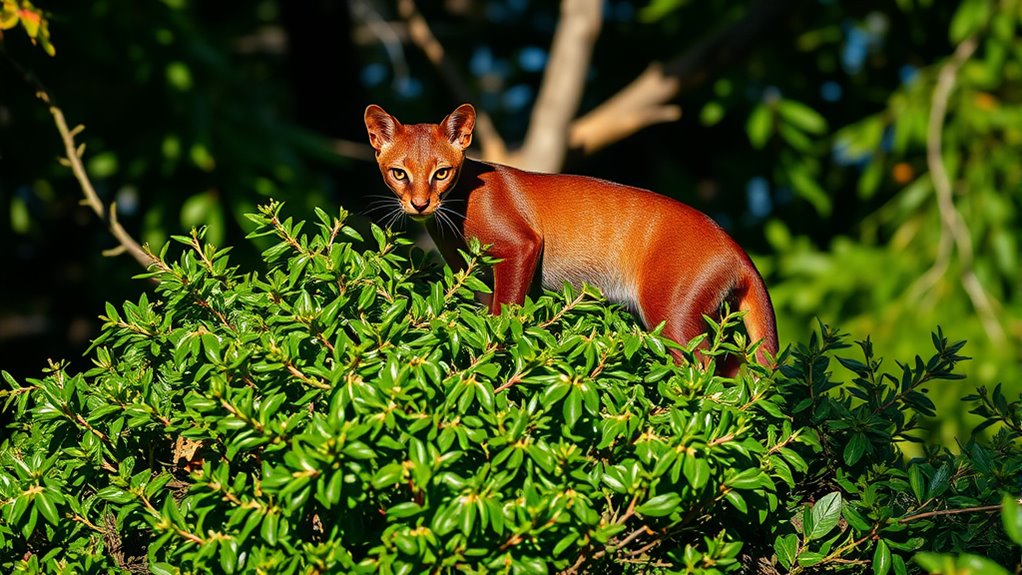
Confirming the jaguarundi’s presence in Texas remains a significant challenge because the creature’s elusive behavior and habitat make sightings rare and difficult to verify. Urban development encroaches on natural areas, reducing suitable habitats and making it harder to spot these cats. Additionally, pet domestication complicates the situation; some people may mistake domesticated or feral cats for jaguarundis, or vice versa. The jaguarundi’s secretive nature means it often stays hidden, especially in areas with busy human activity. Without clear, consistent evidence like photographs or verified tracks, confirming their existence remains uncertain. This combination of habitat loss, human expansion, and behavioral traits keeps the jaguarundi’s presence in Texas an enduring mystery.
Conservation Status and Efforts in the Region
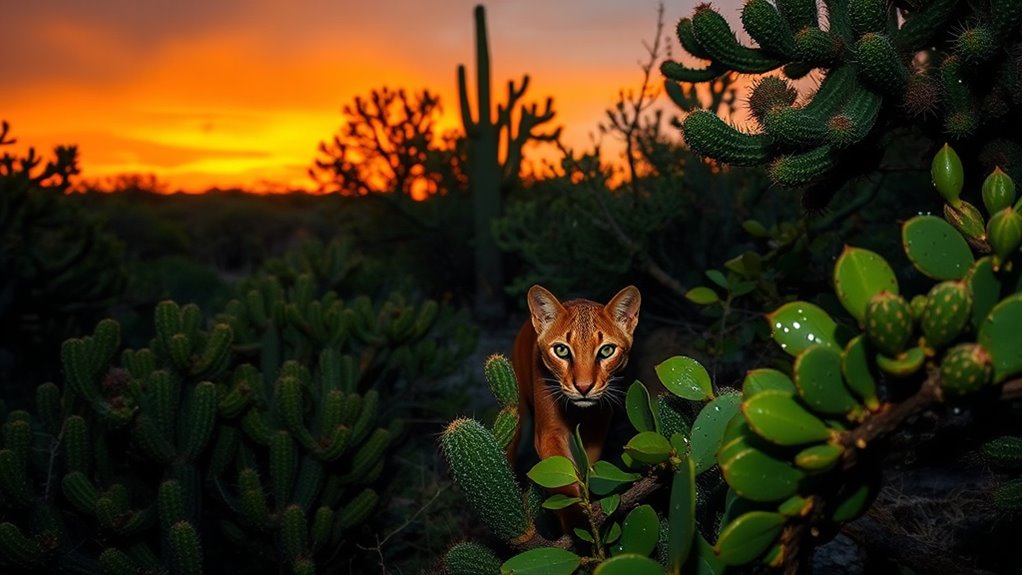
Efforts to protect the jaguarundi in Texas face significant hurdles due to its elusive nature and ongoing habitat loss. Urban development encroaches on its natural environment, fragmenting territories and making sightings rare. Climate change also threatens its survival by altering ecosystems, reducing prey availability, and increasing extreme weather events. Conservation programs focus on habitat preservation, but rapid development and climate impacts challenge these initiatives. You can help by supporting local conservation groups that work to protect remaining habitats and promote awareness. Legislation aimed at limiting habitat destruction is essential, but enforcement remains inconsistent. While the jaguarundi’s status remains uncertain, your awareness and advocacy are crucial in ensuring this secretive wild cat’s future in Texas.
What the Future Holds for the Elusive Feline
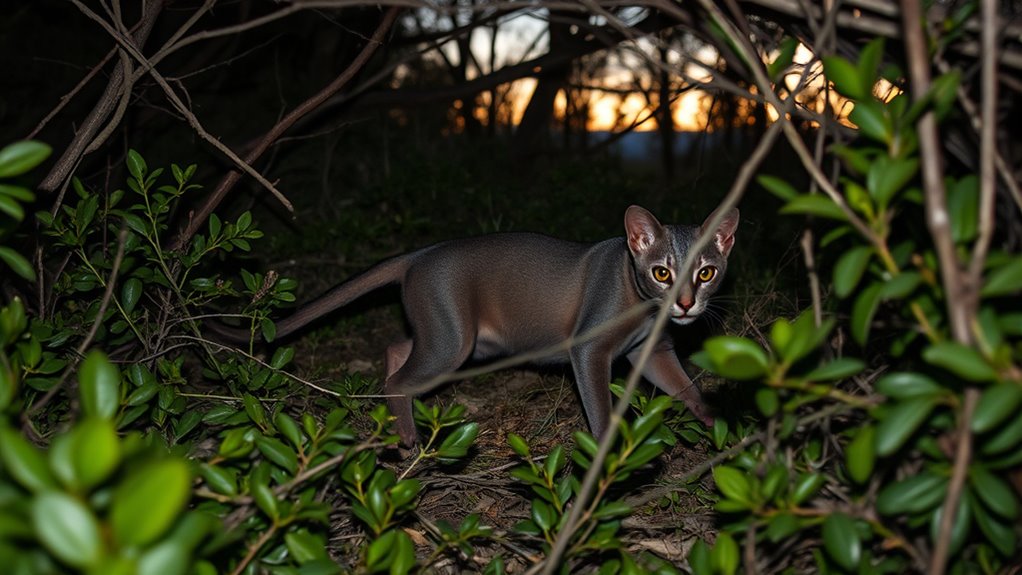
The future of the elusive jaguarundi depends on how effectively conservation efforts adapt to ongoing challenges. You play a crucial role by supporting initiatives that raise public awareness and address conservation challenges like habitat loss and fragmentation. Education campaigns can inspire communities to protect wild habitats, ensuring this secret feline endures. Upcoming efforts will likely focus on habitat preservation and community engagement, fostering coexistence. To visualize the impact, consider this table:
| Conservation Challenges | Public Awareness Strategies |
|---|---|
| Habitat destruction | Educational outreach programs |
| Fragmentation of habitats | Community involvement initiatives |
| Limited research | Promoting citizen science |
| Human-wildlife conflict | Campaigns for coexistence |
Frequently Asked Questions
Are There Any Recent Confirmed Sightings of the Texas Jaguarundi?
Recent confirmed sightings of the Texas jaguarundi are rare, but some reports suggest they might still be around. You should be aware that urban expansion and shrinking wildlife corridors threaten their habitat, making sightings less frequent. If you’re exploring Texas’s wild areas, stay alert, especially near fringes of urban development and protected corridors, where these elusive cats could still be hiding. Your observations could contribute to understanding their true range.
How Does the Jaguarundi’s Behavior Differ From Native Texas Cats?
You’ll notice that the jaguarundi’s behavior differs from native Texas cats like bobcats or ocelots through its more active daytime habits and slender body. Its hunting habits involve stalking and ambushing prey in open areas, unlike other cats that prefer dense cover. This behavior comparison highlights its adaptability, making it a unique and elusive predator in Texas’s wild landscape, often avoiding the more nocturnal patterns of local feline species.
Could the Jaguarundi Be an Invasive Species in Texas?
Yes, the jaguarundi could be an invasive species in Texas. Its invasive impact might threaten native wildlife and disrupt local ecosystems. You should be aware of ecological concerns, as this adaptable cat could compete with native predators for resources, potentially leading to declines in indigenous species. Monitoring its presence and understanding its behavior are essential steps in managing any invasive threats and protecting Texas’s unique biodiversity.
What Ecological Role Might the Jaguarundi Play if Confirmed in Texas?
If confirmed in Texas, the jaguarundi could considerably impact local biodiversity by altering predator-prey dynamics. As a predator, it might help control populations of small mammals and birds, maintaining ecological balance. However, its presence could also threaten native species, potentially disrupting existing food webs. You should consider both its beneficial role in controlling pests and the risks of competition with native predators, influencing overall ecosystem health.
Are There Any Ongoing Efforts to Scientifically Verify the Jaguarundi’s Presence?
You can see scientists actively working in Texas, setting up camera traps and analyzing tracks, all in pursuit of verifying the elusive jaguarundi. These conservation efforts aim to gather concrete evidence of this secretive wild cat’s presence. As you imagine the shadow slipping through the brush, know that ongoing scientific verification efforts continue, bringing us closer to understanding and protecting this mysterious creature hiding in Texas’s wilderness.
Conclusion
As you chase the elusive shadow of Texas’s secret wild cat, you’re chasing a whisper on the wind—an ember flickering in the night. The jaguarundi, with its sleek coat and silent paws, remains a mystery hiding in plain sight. Whether myth or reality, it invites you to look closer, to listen intently. In the end, this feline’s story is a hidden thread woven into Texas’s wild tapestry, waiting to be uncovered by curious eyes.
